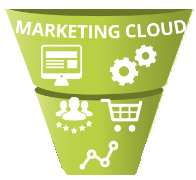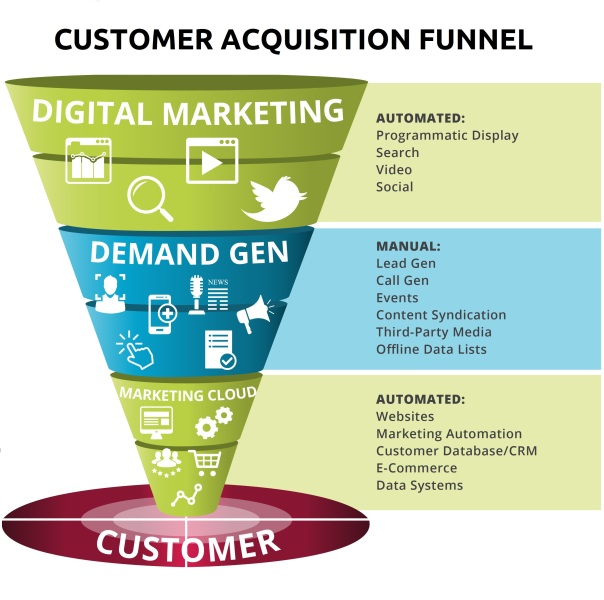Nearly all marketers are using advertising and marketing technologies to automate the processes required to create, execute, and analyze marketing programs. Automation is making marketers smarter about customer needs, behaviors and experiences, while freeing up time to focus on marketing strategy and creativity. In essence, it’s increasing our ability to effectively discover, engage and nurture prospects and create satisfied customers.

I’ve discussed this topic with many analysts, marketing peers and customers – they’re all baffled. It’s clearly time to automate lead gen, content syndication, offline prospecting efforts and the myriad of manual, fragmented Demand Gen processes.
First, let’s define Demand Gen
It’s a marketing discipline that focuses on discovering and engaging targeted audiences to obtain information that can later be used to qualify and nurture prospects. Demand Gen typically encompasses efforts to directly generate prospect-provided data via registrations or requests for information. Tactics include lead gen, content syndication, call generation, events, telemarketing, and purchased “lists” (all of which often require working with third parties), and complement Digital Marketing efforts that primarily focus on driving traffic and generating anonymous audience data via search, social and paid advertising (although these efforts too can be used to generate lead data).
Unlike Digital Marketing, Demand Gen hasn’t yet undergone the automation revolution, which means marketers continue to face significant challenges: more than two-thirds (68%) of companies report struggling with lead generation, according to a Lattice Engines/CSO Insights survey.
To gain the full perspective, let’s set the table on marketing’s current automation efforts in context of the Customer Acquisition Funnel (I understand that the funnel is never exactly linear, but it serves its illustrative purpose here).
Top-Funnel Search and Advertising

- Advertising is being automated with the use of programmatic, retargeting and real-time bidding techniques and technology.
- Search is utilizing algorithms and analytics to increase marketers’ odds and ability to be discovered by consumers looking for specific information.
I can remember just a few short years ago the arms-folded, “no way” attitude of marketers and media pros when they first heard of automated advertising and search solutions. A common response was “There’s no way I would buy ads or make marketing investments determined by machines. This is what I do and I know the best media sources for my brand/clients.” Today, it’s “What’s your programmatic strategy?” Quite a turnaround in thinking.
Attitudes quickly changed and the use of technology to automate top-of-funnel digital marketing channels is paying off. In fact, 59% of marketers say search has the biggest impact on their marketing goals, followed by social media (21%) and pay-per-click advertising (20%), according to Marketing Charts.
Low-Funnel “Marketing Clouds”

This has become critical because, according to Sirius Decisions, the average buying cycle has increased 22% over the past 5 years due to more decision makers being involved in the buying process (B2B) and more options for the consumer (B2C).
These systems provide an efficient and effective way to convert leads down the customer acquisition funnel at higher rates. Let’s break down some of the key automation tools being used in lower-funnel efforts where clients’ systems are put to work.
- Website and analytics software from providers such as Adobe and IBM used to personalize experiences and manage content (among many other tasks).
- Marketing automation from companies such as Oracle, Marketo and Pardot for email and nurturing once a prospect engages with the companies’ website, content, products and people at an event or conference (often the result of Demand Gen efforts).
- Customer relationship management (CRM) systems, often connected to marketing automation solutions and provided by companies such as Salesforce.com and Microsoft. These are used by sales and marketing teams to manage customer relationships, forecast pipeline and track the customer lifecycle.
- Data management, predictive analytics and lead scoring tools from companies like Bluekai, Lattice Engines, and a growing list of others to help marketers develop models and techniques for targeting and serving the right information at the right time to the right prospect/customer. While early for many marketers, this area holds great promise to augment the value of website, marketing automation and customer relationship tech investments.
Automation in these lower-funnel areas has become a key component of every marketing strategy and budget today, as the results continue to prove ROI. Case in point, nurtured leads produce, on average, a 20% increase in sales opportunities versus non-nurtured leads, according to DemandGen Report. And CSO Insights has proclaimed even more value, stating that companies with advanced lead-nurturing tactics drive 50% more sales-ready leads at a 33% lower cost. This is a far cry from when marketers simply generated inquiries and threw them over the wall for sales to sort out.
All this is great, but the reality is that most marketing teams rely on third-party and offline data sources to produce the required volume of inquiries and leads. ENTER Demand Gen, sitting in the middle of the funnel, and to date, neglected by the automation movement.
The Manual Middle-Funnel: Demand Generation

Let’s illustrate the typical Demand Gen efforts in a step-by-step walkthrough (multiplied by the number of providers you may use for each campaign/initiative). A typical marketer uses anywhere from a handful to hundreds of third-party demand gen partners. The amount doesn’t matter as much as the steps, time and resources it takes to get the job done.
Typical Demand Gen Tasks
- Identify the lead/prospect data providers best suited for your market, targets and strategy.
- Select providers using one-off communications with each potential vendor via phone, face-to-face and/or email to learn about specific capabilities.
- Set pricing, terms & conditions and contract with each provider.
- Create individual insertion orders and materials needed for campaign execution. Whether you have 5, 10 or 50 providers, the incredible amount of tedious tasks just to launch adds up quickly, taking away from marketing’s strategic efforts.
- Monitor campaign progress, collecting, processing and analyzing prospect data by each campaign and each provider. In most cases this requires the emailing of lead/campaign data via spreadsheet from each provider on a daily or weekly basis, most of which come over in unique formats that don’t align with your standards or marketing automation systems.
- Review on a daily or weekly basis (depending on frequency of provider lead delivery processes) each spreadsheet or data report you receive, scrubbing data for accuracy and completeness (by criteria such as company size, vertical market, title, etc.). Marketers can’t afford to have bad data flowing into expensive marketing tech systems; nor does it want to hear sales barking about “Mickey Mouse” email labels or a non-existent phone numbers or company names.
- Return bad leads to responsible providers and await replacement leads.
- Upload data, one provider lead file at time, into your marketing auto system so prospects can be nurtured and scored. This extra work costs you precious time between first prospect engagement and required follow-up communications (often measured by lead velocity), effectively diminishing the value of the lead itself.
- Tally campaign status by provider according to the number of quality leads to assure you got what you paid for from each provider.
- Repeat this process on a daily/weekly basis with each provider until each campaign ends, and do it for all subsequent programs.
- And, when the money is all spent and the program is done, you finally analyze which providers, content and tactics actually delivered a positive return on investment. In other words, you have very little, if any, opportunity to optimize campaigns while running.
The Consequences of Manual Demand Gen Are Significant
Marketers are increasingly expected to generate more pipeline and revenue with fewer resources. In addition to inefficient and wasted resources and much-needed time taken from the marketing team on low-value tasks, the resulting bad data (25-30% of leads contain bad data) wreaks havoc on both the customer experience from lagged follow-up and decreased sales productivity due to chasing leads containing erroneous information. And, manual demand gen efforts hamstring the value of the marketing automation and CRM tools we marketers have invested in to effectively nurture leads to customers.
You can quickly see there has to be a better way for marketing organizations to deliver high-quality leads via demand gen! In this modern era of marketing and automation, we should be able to:
- Standardize the management of all data sources so we can work one-to-many with providers, eliminating manual efforts to plan, execute and optimize demand gen campaigns
- Utilize technology to validate and govern prospect data for accuracy and completeness before it’s injected into marketing automation and/or CRM systems
- Capitalize on campaign and provider performance data to reallocate budget and drive significantly better performance and ROI by optimizing toward the best providers, content and channels per campaign
Companies that automate lead management see increases of 10% in revenue within 6-9 months, according to Gartner Research. Imagine how much you can boost revenue by automating all the other demand generation processes.
